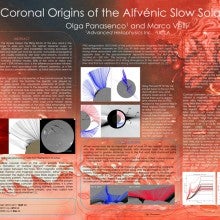Coronal Origins of the Alfvénic Slow Solar Wind
Olga
Panasenco
Advanced Heliophysics Inc.
Marco Velli, UCLA
Poster
As demonstrated by the Ulysses mission the filling factor of the slow wind in the heliosphere is too large to arise only from the helmet streamer cusps, so magnetic field and plasma transport and instabilities involving processes at coronal hole boundaries and quiet sun must be at work. Outwardly propagating Alfvénic fluctuations are usually hosted by fast solar wind streams, however a number of slow solar wind periods have been identified where the turbulence is also dominated by outward Alfvénic modes. 80% of the wind at Helios was shown to be Alfvénic and ~ 37% Alfvenic slow. Is the difference between Alfvénic slow wind and standard slow wind associated with different dynamics, or is the coronal topology at the source completely different, as initial indications seem to show?
Here we discuss magnetic topology and properties of the coronal sources for the peculiar Alfvénic slow solar wind. We illustrate the specific role played by different coronal hole types (polar CHs, equatorial extensions of polar CHs, isolated CHs both at high latitude and close to the equator), as well as by solar filaments and active regions at coronal hole boundaries, that strongly influence the magnetic topology of the lower corona and solar wind properties. Pseudostreamers (PSs) are multipolar features, which develop into open fields that are unipolar at greater heights requiring the presence of two or more nearby coronal holes of the same polarity. MHD solar wind models along magnetic field lines show that the properties of the solar wind emanating from CHs with pseudostreamers are different from regular CHs. Here we demonstrate coronal conditions required for the development of Alfvénic slow solar wind.
Here we discuss magnetic topology and properties of the coronal sources for the peculiar Alfvénic slow solar wind. We illustrate the specific role played by different coronal hole types (polar CHs, equatorial extensions of polar CHs, isolated CHs both at high latitude and close to the equator), as well as by solar filaments and active regions at coronal hole boundaries, that strongly influence the magnetic topology of the lower corona and solar wind properties. Pseudostreamers (PSs) are multipolar features, which develop into open fields that are unipolar at greater heights requiring the presence of two or more nearby coronal holes of the same polarity. MHD solar wind models along magnetic field lines show that the properties of the solar wind emanating from CHs with pseudostreamers are different from regular CHs. Here we demonstrate coronal conditions required for the development of Alfvénic slow solar wind.

Poster PDF
Meeting homepage